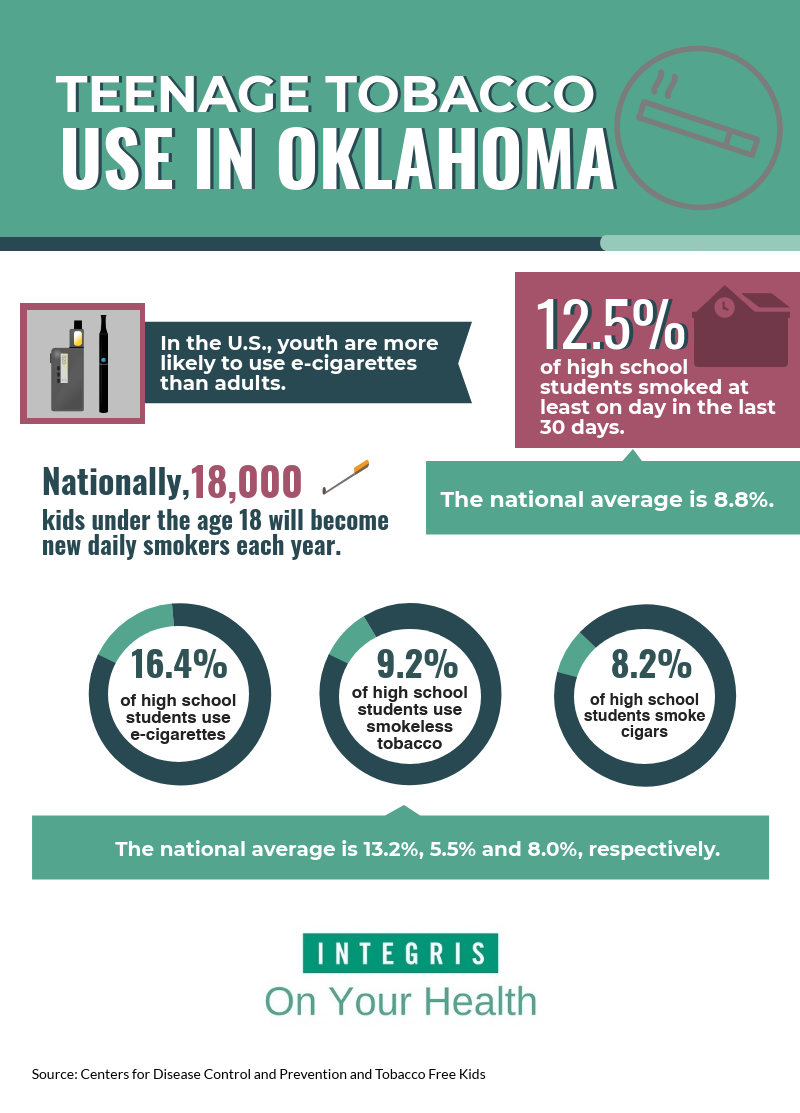Teenage E-Cigarette Use On the Rise in Oklahoma
Posted in

In a recent study, 12.5 percent of high school students in Oklahoma smoked at least one day in the past 30 days. Other studies show that teenagers who smoke are much more likely than smoking adults to use e-cigarettes, and the rate of teenage e-cigarette usage is sharply on the rise. In 2016, a report from the US Surgeon General cited a 900 percent increase in e-cigarette use by high school students between 2011 to 2015.
Electronic cigarettes were first introduced to help people stop smoking, marketed as a less dangerous alternative to smoking regular cigarettes. Unfortunately, e-cigarettes have become widely popular among teenagers, perhaps because of their fruity flavors, luring some teens into smoking who otherwise might never have tried it. In recent news, the head of the Food and Drug Administration called the use of addictive electronic cigarettes among youth “an epidemic.”
The term “e-cigarette” can be applied to many devices. The FDA clarifies that vapes, vaporizers, vape pens, hookah pens, electronic cigarettes (e-cigarettes or e-cigs) and e-pipes are some of the many terms used to describe electronic nicotine delivery systems. In other words, electronic cigarettes typically have a heating element, a container to hold liquid and a battery element.
E-cigarettes create an aerosol or vapor when a person inhales (or “vapes") which normally contains nicotine, flavorings and other chemicals. They come in all shapes and sizes and resemble everyday items like pens and USB ports.
The FDA recently proposed regulations to crack down on these devices and make it harder for teens to buy them.
E-cigarettes in high schools
The Oklahoma 24/7 Tobacco-Free Schools Act requires schools to be 100 percent tobacco-free. The law prohibits the use of tobacco in educational facilities, school vehicles or at school events and activities. However, this act does not mention vapor products, so schools themselves must prohibit vapor products (with or without nicotine) in their specific policies.
Many authorities, teachers and parents are learning how to identify the many types of e-cigarettes to more effectively combat teenage use.
The most popular e-cigarette in schools
The JUUL is the bestselling e-cigarette in the U.S. and is known to provide a “buzz” closest to regular cigarettes. The concentration of nicotine in each JUUL pod is about twice that of other e-juice nicotine concentrations.
With its compact USB design, it is easy to hide and easy to carry, making JUULing the most popular e-cigarettes among high schoolers. It's been reported that some teens use it in classrooms, bathrooms or their own bedrooms without detection.
In recent months, the FDA has cracked down on JUUL labs to restrict the sale of flavors popular with teens and only allow mint, tobacco and menthol flavors to be sold in stores.
What parents can do
The best way to prevent teenage tobacco use is to get involved and educate your teen.
- Talk to your teens about vaping. Remind them it is illegal for anyone under the age of 18 to purchase or use nicotine products in Oklahoma.
- Talk to your teens about the health risks of smoking. There are serious consequences if your teen is using e-cigarettes, including long-term health problems and a high probability of addiction. Make sure you children know the risks.
- If you learn your teen is vaping or smoking, take your child to the family doctor. Get a third party like your family doctor involved to explain how smoking harms the body, perhaps with more graphic information than you are able to provide. Nicotine addiction is a serious issue and a medical professional can help provide guidance.
Teenage tobacco statistics
Nationally, 18,000 teens will become daily smokers each year. In addition, 30.7 percent of teens who smoked e-cigarettes started smoking regular cigarettes within six months.
See below for more statistics.
Effects of teenage tobacco use
Nicotine comes with a full set of harmful side effects – especially when it comes to teens and essential brain development. In fact, the prefrontal cortex section of the brain, which is responsible for controlling attention, impulses and mood is particularly vulnerable to nicotine’s effects in teens. This part of the brain isn't finished fully developing until about age 25.
Nicotine’s addictive capabilities are very strong. Nicotine stimulates the adrenal glands to release the hormone epinephrine (adrenaline) and increases the levels of a chemical messenger in the brain called dopamine. Pleasure caused by nicotine’s interaction with the brain’s reward system motivates some people to use nicotine again and again.
The use of any tobacco product, including e-cigarettes, is unsafe for young people. Studies have shown e-cigarette use exposes the lungs to a variety of chemicals and toxic metals. Additional research is still being conducted to determine just how harmful e-cigarettes are in the long-run.
Prevention of teenage tobacco use
To help aid in the prevention of tobacco use, take advantage of the many resources available online. There are even apps your teen can download to help guide him or her through quitting. We also recommend the Oklahoma Tobacco Helpline, 1-800-QUIT-NOW.


